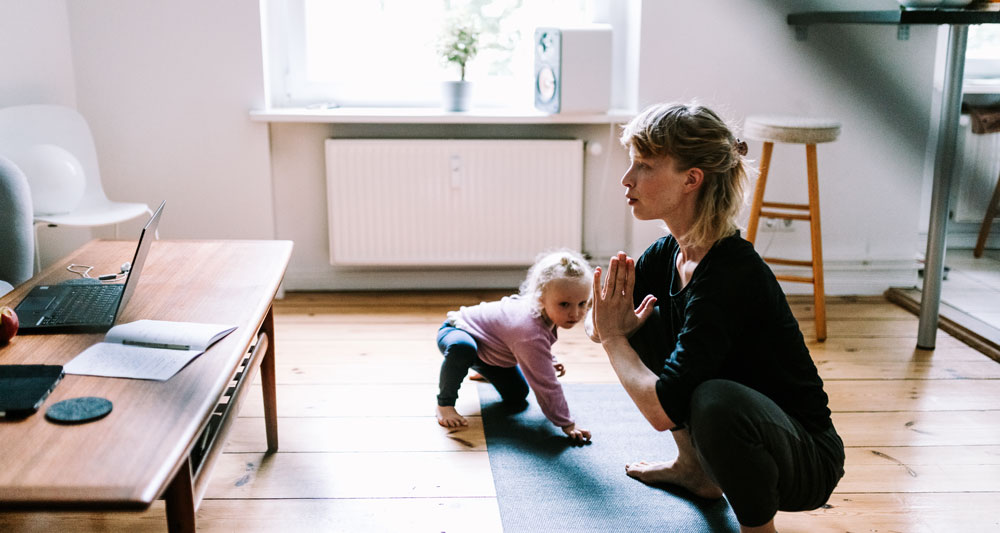Working It All Out: Balancing Work, Family and Physical Activity

January 22, 2021 | By Michael Adkison
Researcher: Christopher C. Rosen
When the world began to quarantine in the COVID-19 pandemic, it felt like the unholy blending of two worlds — home life and work life.
What once was separate and good became one mesh of a daily existence — home, a place once peaceful and pure, suddenly also became an office, a schoolhouse and a playground, often at the same time. Before, you could leave the stresses of one world behind and venture to the other; as you left the office at the end of the day, your home became the sanctuary where you didn’t think about work. Then, overnight, the worlds collided, and peace was disrupted.
How did some people keep it all together?
A quick scan of Facebook revealed a number of options — thousand-piece puzzles, baking sourdough bread, organizing that closet you’d been avoiding for months. But one option that more and more people turned to was working out. Of course, gyms and fitness centers across the country shut down as well, but home workouts and jogging in a socially-distant fashion helped many people stay sane — and healthy — in a period of such uncertainty. And an article from the Journal of Applied Psychology finds that getting that workout in before the end of the work day could help maintain a healthy work-life balance (WLB).
Researchers Charles Calderwood, Allison S. Gabriel, Lieke L. ten Brummelhuis, Christopher C. Rosen and Emily A. Rost delve into the psychology behind maintaining a healthy work-life balance and getting a good workout in. It boils down to the idea of vigor — does working out before the end of the day wear you out or does it keep you active? “We posit prior to end-of-workday physical activity to enhance employee end-of-workday vigor,” the researchers write. “This vigor, in turn, can be applied to simultaneously meeting work and non-work goals of the post-work period.”
A Balancing Act
Running may not be your workout of choice, but exercise research points to a phenomenon commonly called runner’s high. Once you plug in your headphones, hit the trail and find your running groove, your body releases endorphins, which exhilarates you. And that feeling can carry over after the run, into the rest of your day. That feeling of excitement is vigor.
Maintaining the harmony of work life and family life is a balancing act — one that can, at times, be strenuous and tiresome. As such, it’s essential to find ways to stay vigorous throughout the day. For many people, that energy comes from physical activity. But, “employee physical activity has largely been studied within the organizational sciences as a post-work leisure activity that assists in the recovery of personal resources necessary to support subsequent work performance,” the researchers write. In other words, prior studies have generally only focused on working out as a fun pastime, helping employees mentally recover for the next day’s work. But what about maintaining the work-life balance?
“Employees pursue goals in work and family life, with WLB (work-life balance) resulting from goal achievement across domains that is facilitated by boundary-spanning resources that ‘simultaneously facilitate the attainment of a work and family goal.’” After all, consider how great it feels to accomplish something, whether at work or at home. As humans, we’re fundamentally wired to pursue those goals, but we need the energy to do so. That’s where vigor comes in. “We argue,” the researchers write, “that prior to end-of-workday physical activity is key to accruing the boundary-spanning resources of end of workday vigor, which is then used to meet work and non-work goals post work, yielding greater WLB.”
Staying Vigorous
In an effort to better understand vigor, physical activity and a work-life balance, the researchers develop five hypotheses, pointing to the notion that working out before the end of the day can lead to more energy, greater ability to recharge for the next day’s work and more time to devote to family and other hobbies. “We expect prior to end-of-workday physical activity to engender end-of-workday vigor, which allows employees to meet work (i.e., recovery) and non-work (i.e., family absorption) post-work goals, enhancing satisfaction with WLB.” From there, when we retain that energy and vigor, we can apply it to other skills that enthrall us, a trait known as mastery. Combining relaxation, mastery and family time creates that perfect blend we call work-life balance.
In order to test for work-life balance, the researchers analyzed the habits of more than a hundred employees at a university. Each participant was at least 18 years old, worked at least 32 hours a week and worked from Monday through Friday. From there, participants wore a wrist-worn actigraph, similar to your average smart watch, and they catalogued daily surveys throughout the work week, consisting of a morning survey, an afternoon survey and a bedtime survey. The researchers analyzed a number of factors, each pertaining to specific times of day:
- Prior to End-of-Workday Physical Activity (all day)
- End-of-Workday Vigor (afternoon survey)
- Post-Work Recovery Experiences (bedtime survey)
- Family Absorption (bedtime survey)
- Satisfaction with WLB (bedtime survey)
Mind Over Matter
The results of this study further emphasize the importance of physical activity in everyday life. The researchers “advanced theory by exploring how prior to end-of-workday steps influence non-work criteria, identifying end-of-workday vigor as a mechanism through which this physical activity facilitates work and non-work goal accomplishment post-work that enhances satisfaction with WLB.” In other words, physical activity has more than just physical health benefits; it can help with employees’ mental well-being and in keeping their lives balanced. “Our findings also demonstrate that when employees feel more energetic at the end of the workday, they have greater bandwidth to invest their effort in acquiring resources post-work.” Without that vigor at the end of the day, it can be easy to just finish with work and sink into the couch for the rest of the evening — but with the vigor achieved through physical activity, you could channel your time and attention toward family, hobbies or other tasks around the house.
The study demonstrates that prior to end-of-workday physical activity is positively related to end-of-workday vigor, which, in turn, is positively related to post-work relaxation, mastery and family absorption. “Our findings suggest that a physically active pre-end-of-workday period is not necessarily depleting of energetic resources.” In fact, that physical activity often yields vigor, which “can spillover across life domains to support WLB.” If work-life balance is a literal balancing beam, with work on one side and family, hobbies and relaxation on the other, physical activity can act as a sort of magical weight that can hold it all together. “Prior to end-of-workday steps yield gains in the boundary-spanning resource of vigor, which allows employees to simultaneously meet a work (recovery) and a non-work (family absorption) goal, ultimately enhancing satisfaction with WLB.”
Making Movements
If you asked 10 different people how they stayed busy during quarantine, you might get 10 different answers. But almost all of us can agree that we may not have been getting those steps in every day. The walk from bed to the kitchen table, then to the desk from eight to five, and then back to the kitchen table, and then back to bed may not have been the best for our physical well-being — or our mental well-being for that matter. As such, it’s more important than ever to find time for that physical activity. It may seem like a big task when you’re already sitting on the couch and you have an evening’s worth of Netflix content queued up, but it will benefit you in the long run.
As the researchers note, “organizations are increasingly trying to promote physical activity.” Some offices are challenging their employees to weight loss competitions or signing up for a 5k or just encouraging them to work out more.
And it’s not just some menial task to give employees something to do — this study shows that getting that workout in has genuine benefits to the workplace, as well as homelife, and can help you keep it all balanced.


